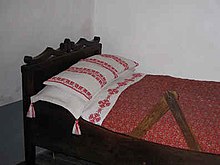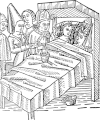bed
The term bed refers to a piece of furniture that is used for sleeping , lying or resting. A simple bed today usually consists of a frame or frame on which a mattress lies. Some mattresses are also self-supporting (for example in some French beds). The "European" bed usually also includes duvets and pillows as well as the corresponding covers and sheets (see bedclothes and bedding ). Reclining furniture (couch, sofa, divan, bed bench), which is also used as seating, is described in the article sofa .
history
precursor

Archaeological finds show that 200,000 years ago people in Africa slept on heaps of grass. Finds from later times (43,000 years ago) also suggest that these sleeping pads were also renewed by burning them and then laying fresh bundles of grass over them.
Antiquity
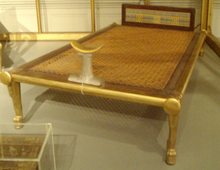
In ancient Egypt there were ornate loungers; as was later the case with the Greeks and Romans , they were used not only for sleeping, but also as loungers at the table, as it was unusual to separate the sleeping and living areas. The ancient Egyptians had long-legged bed frames, which had to be stepped on, were covered with cushions and closed with a mosquito net all around. The semicircular headrests made of stone, wood or metal are characteristic. Assyrians , Medes and Persians had similar beds with brightly colored, splendid carpets and all sorts of ornaments made of metal, mother-of-pearl , and ivory .
According to Homeric tradition, the bed of Odysseus was an ornate four-legged framework, strung with straps of shimmering purple bull skin and covered with furs and carpets. A linen cover and a woolly coat served as a blanket. The ancient Greeks had wooden bedsteads, often with ornate feet and a backrest-like elevation at the head end. The mattress filled with wool or plant fibers and a round head cushion, which were covered with linen towels , woolen blankets, furs or a leather cover, rested on straps .
The bed of the Romans ( lectus cubicularis ) was similarly constructed and often furnished with great luxury. A frame made of wood or bronze stood on mostly bronze feet, which were decorated with precious metal or ivory, and carried the mattress filled with reeds , hay , wool or feathers from geese or swans [ culcita or culcitra (etymologically not entirely clear) on straps - literally: pillow, cushion; torus - literally: upholstery, bed, sofa, bed, marriage bed, love and, accordingly, marriage! Further possibilities: stratum , stragulum ]; At the head end there were small pillows ( pulvinus - seat or pillow; cervical - only in the meaning of the pillow). Blankets ( stragula - Latin plural of stragulum ; tegumenta , operimenta , velamenta ) made of precious fabrics, often with rich embroidery and in purple color, were spread over the mattress . The hangings ( toralia ; singular: toral - literally: sofa, bedspread) were just as rich, reaching from the mattress to the floor. The back of the bed was often provided with a backrest ( pluteus - generally that of a dining sofa , but the dining sofa itself was also given this name in some cases).
Besides these beddings the Romans had the marriage bed ( lectus genialis ), the low sick bed ( lectus aegrotantis , scimpodium ), the actor bed of the Dead ( lectus funebris ), the couch ( lectus lucubratorius ) on which to read, meditate or lying wrote and the low, sofa-like dining bed ( lectus , triclinium - a Greek loan word).
The Latin terms cited are sometimes very ambiguous and varied. An example of the variance in semantics is lectus . This is or was - any attributes not included - u. a. Used to describe the terms bed, camp, day bed, bridal or marriage bed, dining sofa and funeral bed. Wherever possible, the most common terms have been mentioned here, but the overlaps are numerous and thus it depends on nuances which word is to be preferred.
At this time, beds were reserved for the rich upper class. For the broad mass of the population, beds were a luxury; they slept on the floor, had simple beds made of leaves - or straw sacks or simple mattresses .
middle Ages
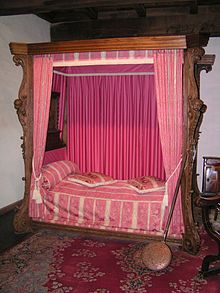
In the Middle Ages , four-poster beds became fashionable. The four-post bed with a canopy ( canopy ) and curtains served as a seat during the day, at night the curtains were drawn and an alcove was formed . From then on, the beds became larger and more spacious, the fabrics finer, the materials more exquisite and the carvings more artistic.
Even in the early Middle Ages, the floor was often covered with carpets, cushions stuffed with feathers ( plumit ) or more tightly with wool or hair ( matraz ), and furs were used as blankets . The bedsteads were originally very similar to the Roman ones and were made of bronze. At that time people usually went to bed naked and wrapped themselves in the large sheet spread over the pillows ( Leilachen , Linde Wat , Linten ).
From the 13th century onwards, greater luxury developed, the wooden bedsteads were decorated, carved and painted with inlaid work. At that time, the beds that were used as sofas during the day were also made. The leather underbed, covered with silk and filled with feathers and covered with the quilted blanket (cult), lay on a four-legged frame covered with ropes. A linen sheet ( lilacs ) was spread over this furniture for the night and some pillows, namely the so-called ear cushions, were added. At the time of the minstrels, eider and eagle down were particularly useful for filling pillows. Silk-covered, fur-lined blankets served as blankets.
Up until the 12th century, only straw was used as a base for ordinary beds . Underbeds and mattresses are only found much later. At that time only very distinguished people used their own bed; the entourage, the knights, had to share a narrow camp in twos or threes.
The main bed for the couple was the most outstanding piece of furniture in the bower . Even then, curtains and bed canopies were fashionable, and hanging lamps were attached to the latter as night lights . The head of the bed was always placed against the wall so that one could climb into the bed from both sides. In doing so, however, a not too wide room ( la ruelle ) was left between the bed and the wall on one side as a reception area for intimate friends, the beginning of the later boudoir (a small, elegant ladies' room).

In the Middle Ages, the deathbed (Latin articulus mortis ) acquired a circumscribing meaning in the meaning of "hour of death".
Modern times
Real alcoves did not come into use until the 16th century.
Gradually the luxury rose, the bed furnishings increased, and the size of the bed grew to such an extent that in the 15th century it stood like a house in the room, big enough to accommodate a whole family. Wooden bed niches or wall beds were also common in farmhouses . The beds of the Renaissance are true masterpieces of wood carving .
At the princely courts one had parade beds, which were used less for sleeping than for representation purposes and which were set up in state rooms. There were equal and superior personalities, such as B. foreign ambassadors received. An audience was granted in the parade bedroom. This is where the public getting up and getting dressed, French : “ lever ” and going to bed, French : “ coucher ” took place as a ceremonial act in the strictest hierarchy. In the time of the French King Louis XIV , the bed became the absolute showpiece of furniture. Precious fabrics replaced rare woods, gilding and carvings. Velvet, satin, silver fabrics, brocade, damask and embroidery almost completely made wood disappear. The decorator's art surpassed that of the carpenter. Support posts at the four ends of the bed no longer had a canopy. This was still attached to the ceiling “à la duchesse” or “à pavillon”. As a “lit d'ange”, it is already shorter than the bed below and is attached in a self-supporting manner. These beds were crowned with vases, tassels or plumes. After the first quarter of the 18th century, the parade bedroom had served its purpose as a reception room.
The beds of the affluent bourgeoisie, which were increasingly oriented towards the nobility, were similar, albeit with less luxury. Gradually, however, the shape of the bed frame changed; it gradually took the form of a box (bed drawer) in which the bed pieces were then piled up. In the 18th century the heavy feather beds , plumeaus, appeared. When the bed finally went into mass production , the ornate decorations disappeared again. The beds were now made of simple materials such as iron or wood and gradually became affordable for everyone.
Artful decorations and expensive materials hardly play a role in bed production these days; sleeping comfort and ergonomic aspects are much more the focus.
Bed shapes
Baby and cot
In contrast to beds for adults, baby beds are specially adapted to the needs of newborns, babies and toddlers. With the usual dimensions for the lying surface of, for example, 140 cm × 70 cm, they are significantly smaller. In addition, a frame or grid protects infants and toddlers from falling out. The distance between the bars of a grid should preferably be between 4.5 and 6.5 cm. In addition, the bars should not bend and should therefore be sufficiently stable. To make it easier to get in and out and to avoid injuries, some of the bars that are lying next to each other can be removed from many baby beds. These bars are called slip bars .
A cot can also be equipped with a canopy. It is a tent-like construction that hangs over the bed. Usually an additional rod is mounted above the head end, on which a suitable cloth can be hung. The practical benefit lies first of all in the slightly darkening effect. The bed canopy effectively shields or attenuates direct sunlight. In addition, a bed canopy provides additional security.
Another feature of baby cots are castors. These are particularly useful when the local position of a baby bed is changed regularly, for example when it is to be in the parents' bedroom at night and in the children's room during the day.
Thanks to the height adjustment of the slatted frame , children's beds can be adjusted to be easy on the back for the parents as long as they still have to lift the baby out of bed.
Numerous baby bed models can be converted. This allows you to transform the baby cot into an extra bed for the first few weeks or later into a cot in just a few simple steps. In this way, the bed can be used for several years. The extra bed function enables the baby cot to be placed next to the parents' bed and attached to it. Instead of a surrounding grille, the side facing the parents' bed is open.
Since children have less standing height, bunk beds for children can also be used in apartments with a low ceiling height in order to make better use of the space in the children's room. Bunk beds for children can have a slide next to the ladder.
The cradle is a traditional form of the baby cot ; At the beginning of the 19th century, the bassinet, which was originally restricted to western cultures, also appeared .
Bed frame with mattress
This is the most common shape today. The bed frame is usually made of wood or metal. A slatted frame rests on it , on which a mattress lies. Both together should enable sleep that is beneficial for the back. There are different variations such as the double bed , two single beds mounted side by side ( double bed), the loft bed or the bunk bed . Usually a so-called bedside table is provided or attached to store books, clocks, glasses, alarm clocks, etc., to store handkerchiefs, contraceptives and other items. Often there is a bedside lamp on this cabinet or a so-called night light is installed with the switch within reach on the wall next to the bed.
Bunk bed
In the case of bunk or bunk beds, two or more beds or loungers built on top of one another save space. They can be found very often in children's rooms, military facilities ( barracks ), youth hostels , youth hostels or hikers' huts. A place of use for bunk beds were or are also workers' dormitories, seaman's homes or living containers on construction sites or for accommodating seasonal workers , for example when harvesting. Bunk beds are also often used in prisons and penal camps .
They are also called bunk beds on ships .
Folding bed
A folding bed, also known as a wall bed, can be folded up during the day and then resembles a closet in terms of design. The bedding is tied with straps for this purpose. Folding beds are often integrated into wall units. The advantages are the space savings and a more appealing look in combined living rooms. Because of the poor air circulation, not all types of mattresses can be used. Furthermore, folding beds need a firm anchoring in the wall because they are equipped with strong springs to make it easier to fold up and to keep the folded up bed securely in position.
Camp bed
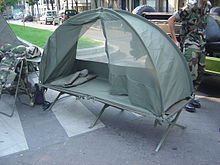
The camp bed is a frame made of wood or metal (mostly aluminum) that can be folded up like a folding chair and is covered with tear-resistant fabric in the form of a portable lounger. The name comes from the military sector, since the cot could be transported to the theater of war with "into the field" and it was designed to be folded up small. In the first aid hospitals there were almost exclusively camp beds. As the material was chosen primarily ash wood or teak .
Camp beds create a distance to the possibly cool, damp and inhabited floor. They also provide a certain mechanical protection against nocturnal insects, scorpions, mice, snakes and other animals, especially in tropical areas, especially when combined with mosquito nets . Camp beds that have been set up can also provide animals with welcome coolness or shade.
Variants of the camp bed are:
Camping bed
A camping bed is nowadays made of aluminum or galvanized metal; their frame can be folded like a “U” or a “Z”, and their legs are usually closed “U” -shaped brackets. Some camping loungers have a sun visor or a tray for placing or storing items.
Carp bed
A so-called carp lounger is built similarly to a camping lounger, it always has four or six or eight individual feet, which can be set up in soft ground with the help of widenings, so-called "mud plates". They are mainly developed as a piece of equipment for carp anglers . Stable constructions with a load capacity of up to 200 kg are not uncommon.
Garden lounger
A sun lounger is similar to a camping lounger, but in most cases its frame cannot be folded up. The lying surface is made of wood, plastic, mesh or fabric. Some models have two fixed wheels or can be adjusted locally using runners . See also deck chair .
Double beds
The smallest double bed is the French bed with a width of 1.40 m, followed by the queen size bed , which is 1.60 m wide and consists only of a single mattress. The next larger is the 1.80 m or 2 m wide king size bed . The wide variants are often equipped with two mattresses, so that a gap arises between them, the so-called "visitor crack ", also called graves or graves in southern Germany . This visitor gap can be filled with a T- shaped, 15 to 25 cm wide piece of foam , which is called a love bridge, crack filler, mattress wedge or double bed bridge. Beds with a continuous mattress are also known as grand lit (also written as grand lit ). A certain width is not associated with this term.
Futon
The futon bed comes from Japan . A mattress about ten centimeters high is covered with kake buton , also made of silk or cotton. This also yogi called duvets is also available with sleeves and collar, so that they can be tightened. Pillows ( makura ) are also part of the futon. In the western world , the term futon has its own meaning.
Box spring bed
The box spring bed originally comes from America , which is why it is also called the "American bed". "Box" here means box or box and "spring" means spring. It consists of a spring box that stands on feet with a mattress and partly a topper.
Sleigh bed, boat bed
A sleigh bed (Engl. Sleigh bed ) or Kahn bed (French. Lit en bateau ) is a bed with raised head and foot. The name comes from the fact that the piece of furniture with its boat-like side walls looks similar to a traditional horse-drawn sleigh or a box-shaped boat.
Canopy bed
The four poster bed is a bed, with the - mostly on extended bedpost - a canopy , called a canopy or canopy is attached and seems almost to float. The canopy is usually made of textile material, but sometimes also of wood or other material. The canopy is partially complemented by side curtains, creating an intimate and thermally protected space. Because of this property, the four-poster bed was very common in the Middle Ages with its often poorly heated rooms. Similar to the alcove , not only is the heat retained, but mosquitoes are also kept out by the curtains.
Loft bed
The loft bed is a bed with a lying area well above the floor so that the space below can be used as a living area or storage space. Beds that are in a niche above the floor can also be called loft beds.
Cot
When crib side-mounted protection grille from falling out of bed. To climb onto the bed, the grille can be folded away or the bars removed. Cribs are primarily used for babies, toddlers, and mentally confused people. Baby cots that are sold in Europe must comply with the DIN EN 716 Part 1 + 2 standard.
Nursing and hospital bed
The care bed differs from the normal bed in that it has (manual or electrical) adjustment options for the lying surface and lying height. The lying surface of the slatted frame is made up of several parts (at least 4 parts). Each individual part can be adjusted according to the wishes and condition of the person lying down. The basic functions of the back section and the leg area are adjustable, the entire system can be raised to around 80 cm ( working height in care) or lowered to reduce the consequences of a fall. It can thus be adapted to the needs of a bedridden or in need of care and facilitates care. Bed side parts can provide orientation and prevent unintentional falling out or leaving unattended in the sense of a fixation . The hospital bed also has the properties described, but can be expanded in a variety of ways and is specially adapted to clinical requirements.
Nursing bed or extra bed
A special form of the cot for infants is the nursing bed, which is added to the parents' bed. It is positioned and fastened directly to the parents 'bed so that the mattress of the cot is flush with that of the parents' bed. Colloquially, these beds are also referred to as baby balconies , as they add an additional area to the parents' bed like a balcony in an apartment. The child sleeps in close proximity to the parents . This enables the mother to breastfeed her baby at night without having to get up, and the child can feel the closeness of the parents and usually sleeps much more calmly than in a cradle . The baby balcony is also suitable for small children if it is long enough.
Senior bed
Commercially available bed with the special feature of a raised lying surface (50 cm and higher). The aim of this higher lying surface is to have your feet above the floor in the sitting position. Then you can slip out of bed and there is a mixed movement that significantly reduces the usual effort of lifting the body when standing up. However, this advantage when getting up is often bought at the cost of greater effort when entering.
Day bed
A day bed is a narrow day bed that is usually in a separate room from the bedroom. It can stand freely in the room or with one long side against the wall, making it suitable as a sofa-like seat. Some day beds offer storage space under the bed to accommodate bedding.
Waterbed
In the case of a water bed , the mattress is filled with water. This form of bed was used in Persia around 3000 years ago . Goat skin sacks were filled with water to sleep on. These early waterbeds could cool when filled with fresh spring water or warm when placed in the sun during the day. The waterbed was not rediscovered until the middle of the 19th century. In 1885 the waterbed was sold in series . Because of the even weight distribution, water beds are z. B. used for pressure ulcer prevention in patients who cannot move themselves. Nowadays waterbeds are mostly heated electrically.
Improvised sleeping place
Instead of a bed, a hammock or a combination of air mattress / sleeping mat and sleeping bag is often used as an improvised place to sleep on trips and expeditions .
Bed sizes
In Germany, the dimensions of a bed usually refer to the inner dimensions of the bed frame. This information is roughly the same as the information for the external dimensions of the mattress and the slatted frame . According to DIN or EN 1334, the slatted frame should be 5–20 mm narrower and 10–40 mm shorter than the inner dimension of the bed frame. Mattresses for single and double beds are available in lengths of 190 cm, 200 cm, 210 cm and 220 cm. The external dimensions of the bed are larger according to the design. Bed sizes and widths common in Germany:
| To weigh | Cots | Single beds (width) | Double beds (width) |
|---|---|---|---|
| 40 × 90 cm | 60 × 120 cm | 80 cm | 140 cm |
| 70 × 140 cm | 90 cm | 150 cm | |
| 70 × 160 cm | 100 cm | 160 cm | |
| 90 × 160 cm | 120 cm | 180 cm | |
| 190 cm | |||
| 200 cm |
Other names
In Germany the bed is colloquially referred to as mole , bunk , heia , trap or box , in Switzerland as Näscht (nest) and in Austria going to bed is regionally referred to as “in d ' Hapfn ” or “to go to Nursch ” (Nursch = Called trough).
A bed that was mainly used for cohabitation was previously known as a lotter bed .
Lack of beds
A lack of living space or sleeping accommodations led to the fact that at the time of industrialization, beds were rented out to sleepers (including bed-goers or sleepers) during the day .
Beds in the fine arts
People in beds are a popular motif in painting . From the bed as a place not only of sleep and dreams , but also the togetherness of married couples and lovers, of tenderness and sex , to the bed as a sick bed and traditional place of death, there are countless pictures with this motif. Other subjects are bringing children to bed and the bed as a natural environment for nudity or as a place to read. The bed is rarer as a place of birth and only recently have the bed or the bedroom it has shaped as the main object to be seen in pictures.
gallery
The bed as a place to sleep; by the master of the pericopes of Henry II. Josef's dream , before 1014
Birth of Mary , Gospels from St. Peter in the Black Forest , around 1200
Bridal blessings for Reymont and Melusina , 15th century
The bed as a place for reading (and cracking fleas), Carl Spitzweg Der arme Poet , 1839
The bed as a place of togetherness, Henri de Toulouse-Lautrecs The Bed , 1893
Undressing and Prostitution , Hermann Vogels (1856–1918) Do you like them?
political nightmare , the bed in the cartoon , James Gillray's Comfort’s of a Bed of Roses , April 21, 1806
Nudity, reading, breakfast, Hermann Fenner-Behmers The Bookworm , 1906, printed around 1910
Bedroom of Vincent van Gogh (1853-1890)
Death bed with complaining children, Jean-Baptiste Greuze (1725–1805)
Sleep medical considerations
Unsurprisingly, the sleeping environment has a significant impact on sleep and its quality. The investigation according to sleep medicine aspects using polysomnography has shown that differences in the sleep structure depending on the bed system can be demonstrated. The evaluation showed a significant increase in deep and dream sleep with unchanged movement activity and less fatigue and a better mood when getting up while sleeping in an optimized bed system.
See also
- " Beds ", promotional video
- Bedding
- Sleeping bag
- Slatted frame with a historical treatise from the time before the slatted frame (1957)
- bunk
For other ways of sleeping, see
- Futon (Japan)
- Kang (China)
- Cradle (Germany)
- Hammock (South America and Central America)
- Charpai (India).
literature
- James N. Blyth: Notes on beds and bedding, historical and annotated. London 1873
- Anthony Burgess : cradle, bed and chaise longue. A short cultural history of lying down . Südwest-Verlag, Munich 1985, ISBN 3-517-00889-3
- Annie Carlano, Bobbie Sumberg: Sleeping Around. The Bed from Antiquity to Now . University of Washington Press, Seattle 2006, ISBN 0-295-98598-4
- Klára Csilléry: bed . In: Lexicon of the Middle Ages (LexMA). Volume 1, Artemis & Winkler, Munich / Zurich 1980, ISBN 3-7608-8901-8 , Sp. 2087.
- Pascal Dibie : How to make a bed . Klett-Cotta, Stuttgart 1989, ISBN 3-608-93135-X
- Konrad Haemmerling (under the name Kurt Moreck): Sittengeschichte des Bettes. In: Leo Schidrowitz (Hrsg.): Moral history of the intimate: bed - corset - shirt - pants - bathroom - toilet. The history and development of intimate everyday objects. Vienna and Leipzig 1926, pp. 7–79.
- Agnes Husslein-Arco: Sleepless. The bed in history and contemporary art . Vienna 2015, ISBN 978-3-902805-64-5
- Josef Kern: "How to make a bed ..." Comments on the subject of the bedroom , in: Bayerische Blätter für Volkskunde , NF 4 (2002) issue 1
- Heinrich Mehl: bed story (s). On the cultural history of bed and sleeping . Schleswig-Holstein State Museum, Folklore Collections, Schleswig 1997
- Hans Wentzel: Bett, Bettstatt, Bettstelle , in: Reallexikon zur Deutschen Kunstgeschichte , Vol. 2 (1938), Col. 383–393
- Lawrence Wright: Warm and Snug. The History of the Bed . Routledge, London 1962
Web links
Individual evidence
- ↑ People slept on comfy grass beds 200,000 years ago , Ars Technica , August 14, 2020, based on article Fire and grass-bedding construction 200 thousand years ago at Border Cave, South Africa in Science , Vol. 369, Issue 6505, pp. 863 –866, DOI: 10.1126 / science.abc7239, August 14, 2020, both accessed on August 19, 2020
- ↑ Robert Damme: The Stralsund vocabulary. Edition and investigation of a Middle Low German-Latin vocabulary manuscript from the 15th century. Cologne / Vienna 1989 (= Low German Studies. Volume 34), p. 252.
- ↑ Kazuko Koizumi, Traditional Japanese Furniture , 1986, p. 102. ISBN 978-0-87011-722-0
- ↑ Hapfn , volkswoerterbuch.at (no entry in the dictionary yet)
- ↑ Nursch , volkswoerterbuch.at (no entry in the dictionary yet)
- ↑ Entry Lotterbett , Duden, accessed on August 21, 2020.
- ↑ Ingo Fietze et al .: Influence of the bed system on sleep . In: Somnology . tape 16 , no. 4 , 2012, p. 263-270 , doi : 10.1007 / s11818-012-0584-7 .




